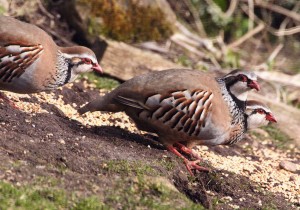 There are two attractive birds to be found in the eastern parts of the Highlands that are there because of introductions. On of them, the pheasant, we take as being native because they are so common in some areas and are readily seen. Pheasants can also be quite tame and will often be seen on the side of roads and adjoining fields and even in gardens. They sometimes even come to bird tables and look rather incongruous in such a setting. The other bird is much smaller and less conspicuous, the red-legged partridge. The pheasant has had a long history of introductions and is the mainstay of many of the shooting estates in the eastern Highlands.
There are two attractive birds to be found in the eastern parts of the Highlands that are there because of introductions. On of them, the pheasant, we take as being native because they are so common in some areas and are readily seen. Pheasants can also be quite tame and will often be seen on the side of roads and adjoining fields and even in gardens. They sometimes even come to bird tables and look rather incongruous in such a setting. The other bird is much smaller and less conspicuous, the red-legged partridge. The pheasant has had a long history of introductions and is the mainstay of many of the shooting estates in the eastern Highlands.
Archaeological remains shows the pheasants were introduced into Britain as long ago as 55 BC and 400 AD by the Romans. However, they do not seem to have reached Scotland until the 16th century. Large increases took place in the 18th and 19th centuries and this is clearly shown in the Old and New Statistical Accounts of 1791- 1799 and 1834-1835. The accounts are fascinating and are the envy of many countries in the way they relate to the countryside and what the people were like particularly in the earliest of these accounts. A few years ago I examined these first accounts in some detail and the results from not only the birds but also the farming details were very revealing. It was a time, for example, when polecats were widespread as were black grouse. Now the scene has been transformed with some local estates releasing thousands of pheasants each year for shooting.
The introduction of the red-legged partridge is a much more recent phenomena although they were brought into Britain from the continent as early as the 17th century. The introductions failed for various reasons but in the last few decades numbers have been brought in annually but not in anywhere the same numbers as the pheasants. It seems likely that they just cannot survive without continual introductions, including in the Highlands. They can survive better that the native grey partridge because the chicks do not rely on insects anywhere near as much in their first few weeks. When first released the partridges can be very tame especially around their release pens where they congregate for food. Many sportsmen do not like them compared with the grey partridge as they are poor fliers and sometimes prefer to walk or run away rather than fly.
It seems likely that none of the birds in most, if not all areas, are self sustaining. There are a few mild summers when they do breed and in the last few years there have been reports of coveys of chicks and later adults in some of the straths around Inverness. However, they have had difficulty in coping with the last three winters of very bad weather. Around Inverness on the south side they have, in the last three or fours years, been occasionally reported visiting bird tables and I have had them on mine occasionally along with pheasant and even mallard. Last week the birds in the photograph came into my garden one morning and the following day were actually under the bird table. They were feeding on mixed grain and the birds looked very attractive and may now stay and breed. How they managed to survive the very bad winter is just amazing. Unfortunately they often fall prey to the ever attentive hooded and carrion crows. In recent years these crows seem to be on the increase mainly because any intensive trapping is localised and not over large enough areas of the countryside.
